
October 16, 2023
During the Execs In The Know Customer Response Summit in Nashville, we reviewed the generational differences in the current frontline workforce, supported by current research conducted by COPC Inc. Senior CX leaders provided valuable input and experiences in this interactive session. We share some of the key highlights from these insightful discussions below.
Amid the evolving dynamics of the modern workplace, it is imperative that leaders acknowledge and embrace the diversity inherent in generational differences. These differences influence how individuals perceive and approach work — understanding them is vital for effective leadership and organizational growth.
Today’s multigenerational workforce brings together unique values, communication styles, work preferences and even technology habits. Understanding what motivates each generation can help administrators and employers capitalize on the changing workplace.
The Five Generations in the Current U.S. Workforce
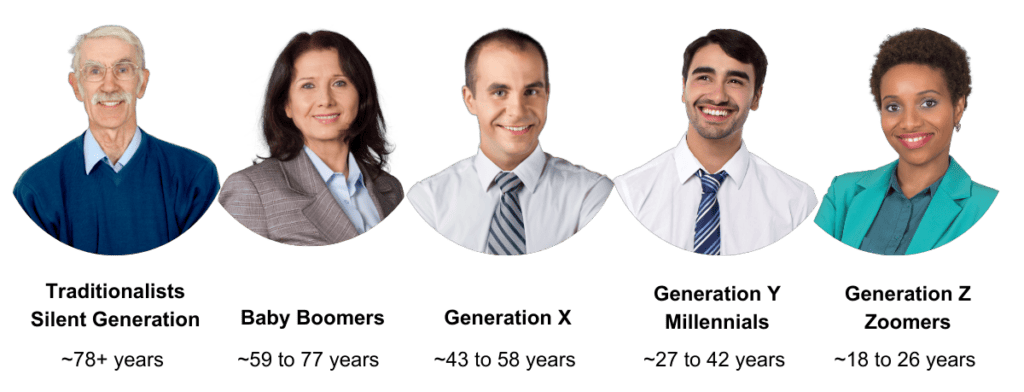
Adapting to Evolving Work Environments
The nature of work environments has seen a significant shift over the years. Older generations often view traditional office setups as the standard way of working, valuing face-to-face interactions and a structured workday. In contrast, younger generations tend to prefer flexibility, valuing remote work options and a balance between work and personal life.
Each generation is shaped by the historical, societal, and technological context of their formative years. Baby boomers were influenced by post-war stability and economic growth, resulting in a strong work ethic and loyalty to their employers. Millennials and Generation Z, on the other hand, have grown up in a highly digitized world, valuing collaboration, innovation, and the integration of technology into their work lives.
Based on the research in Figure One, it might be surprising to note that all generations surveyed had flexibility in working hours as a top-four priority. While it would be accurate to say that Generation X values flexibility the most, all generations value it as significantly important.
This data is based on a contact center frontline professionals survey, so those in the corporate office should consider that those in the customer experience organizations value flexibility very much. Therefore, frontline professionals will value a job that offers flexibility in working hours even compared to areas one might not find as logical, such as growth opportunities (see Figure One below).
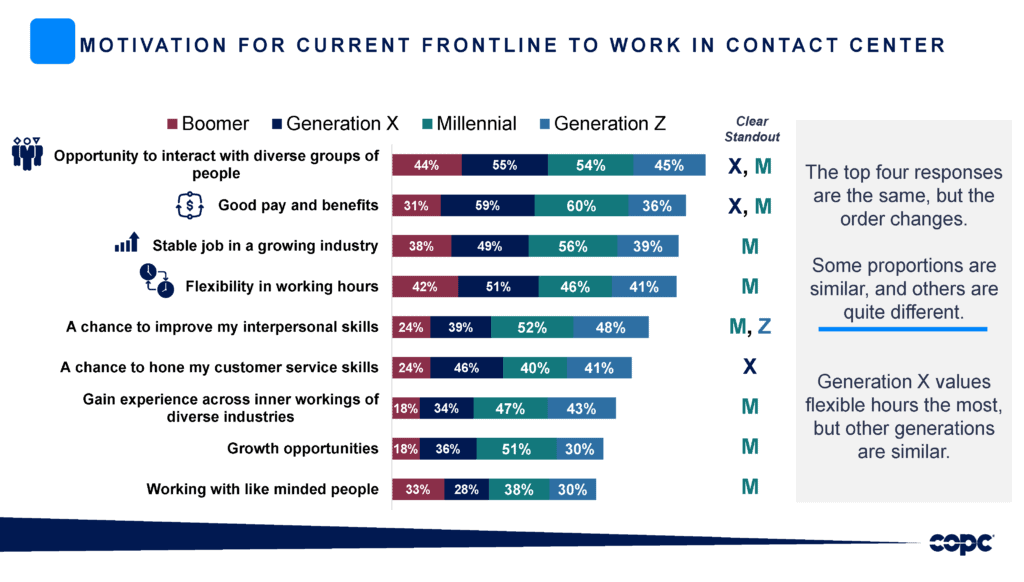
Generational differences extend to work-related preferences and styles. Older generations often appreciate a hierarchical structure and a clear plan, while younger generations value a more collaborative and informal approach. Our research showed that there was broad agreement on the top four most valued criteria, as shown in Figure One. However, there were differences in how each generation ranked the top-most valued criteria, as shown below in Figure Two.
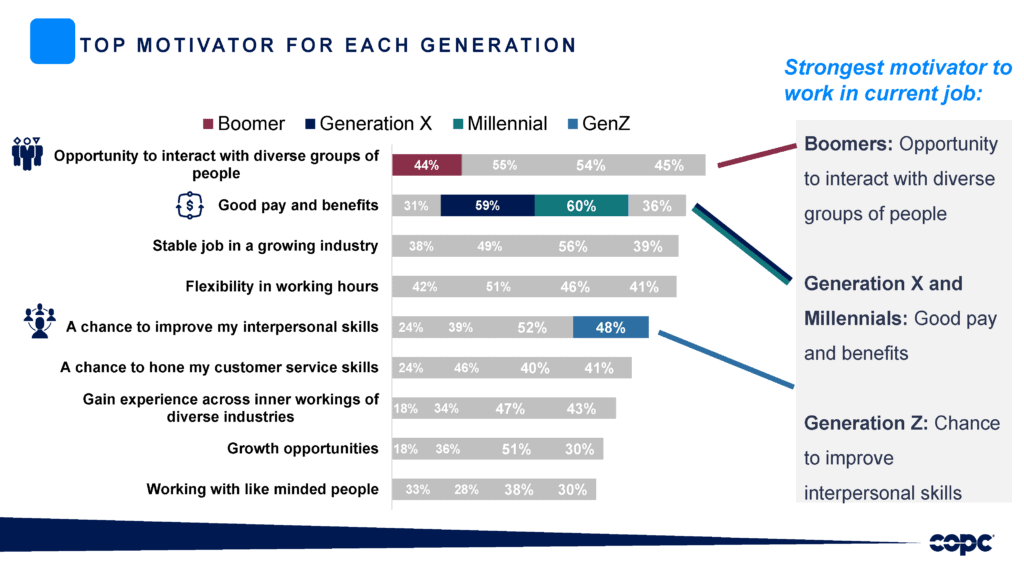
Generational Motivators
Organizations can take advantage of the needs of their employees by better identifying and matching those items that appeal to their generational makeup. Then, providing choices that may appeal more to the individual regardless of their generational identity.
Based on Figure Two, if you primarily focus on providing growth opportunities and experiential learning to millennial agents, you may be overlooking key aspects that are highly valued by this demographic. These include compensation and benefits, opportunities for diverse interactions, and flexible working hours.
Work-at-Home vs Work-from-Office Dynamics
There was wide agreement among participants regarding the differences between generations and a prevailing sense that part of the dilemma between work-at-home vs. work-from-office stems from generational dynamics. Specifically, the preference for office work by boomers and older Generation X leaders does not resonate with the younger generations. This generational divide contributes to the ongoing debate about where work should take place.
During the pandemic, leadership had to adapt to remote work arrangements. The younger generations now see little reason to want to be in an office when, from their perspective, they can replicate the cultural norms via Slack (or other platforms) and visual storytelling vs. water coolers and lunchrooms. Interestingly, there have been successful leaders who have recognized the potential of online communities, even going so far as to leverage them within their organizations.
In the case of frontline customer experience professionals, it is even more important that the leadership of these organizations give voice to frontline preferences as compared to jobs where teamwork in closer proximity is seen as a value-add as opposed to working from home.
Fostering a frontline workplace culture that integrates the diverse expectations of different generations is essential. It involves creating a flexible work environment that offers both traditional and remote work options, allowing employees to choose what suits them best.
The Importance of Work-Life Balance
Since boomers are work-oriented, it was not surprising to see in the research that they placed less emphasis on work-life balance than other generations. What was surprising was just how much more aligned the youngest three generations were at 97%+.
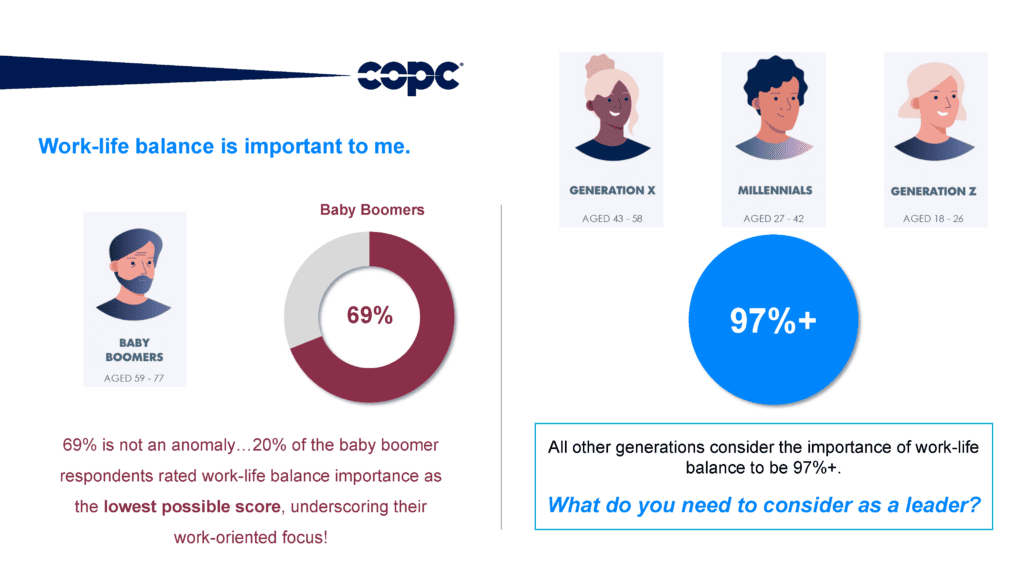
During the Execs In The Know session, leaders shared an interesting observation regarding the relationship between work-life balance and the preference for remote work. They noticed a striking difference in the number of applicants between job postings that mentioned “remote” versus “office-based” positions.
In fact, the remote job postings received an astounding ten times more applicants. This trend clearly indicates frontline agents’ strong desire to strike a balance between work and personal life. It allows them to have more control over their choices by working remotely, reducing both stress levels and transportation costs.
In general, the workshop group from the Execs In The Know Customer Response Summit in Nashville agreed that this was yet more proof of the evolving dynamic of employee expectations on the frontline. They could distinctly perceive the shift taking place, and leaders dedicated significant time to comprehending and communicating this evolving dynamic of frontline expectations. It was evident that merely increasing monetary compensation is not the solution, but rather, offering a wider range of choices.
Putting it All together
Another interesting conclusion from the data was to compare each item against each generation in a data array. What you can see from Figure Four is that no matter what the criteria are, they become more important with each successive generation. The best way to review this data is line by line.
You can see that boomers value each item the least as compared to the three to the right. Yet, the three successive generations largely value each item more than the generation before it. At least to the point that the youngest of the two generations, millennials and Generation Z, are green on all fronts. Note that Generation Z placed 100% importance on Work-Life Balance and Salary.
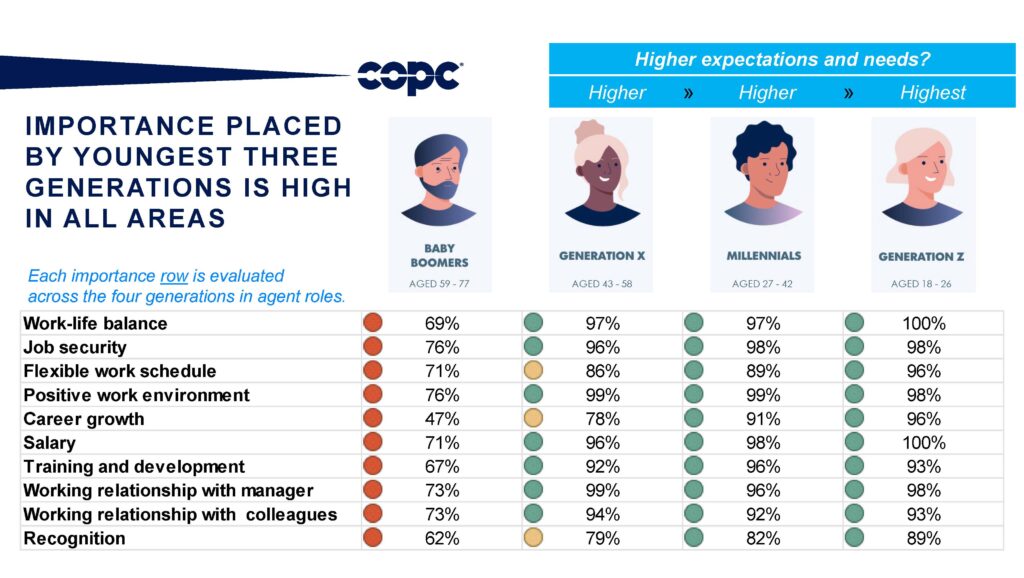
Summary
In conclusion, acknowledging and embracing generational differences in the workplace, particularly in the frontline customer experience workplace, is fundamental to fostering an inclusive, harmonious and productive organizational environment.
By leveraging generational differences, organizations can promote understanding and collaboration, ultimately driving success and growth. At the same time, by modeling a sincere desire to listen to the individual and understand needs, leaders can capitalize on the changing workplace by offering choices, not edicts. As leaders, adapting to and valuing these differences will undoubtedly contribute to achieving organizational objectives and fostering a prosperous future.